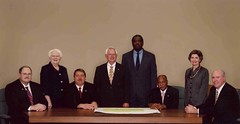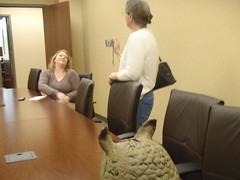
The Valdosta Daily Times seems to have
a reading comprehension problem:
In denying the Lowndes County Commission the right to expand under the current proposed “superdistrict” plan, the DOJ stated in its opinion, “Our analysis of the evidence precludes a determination that the county has met its burden of showing that the proposed plan was not adopted, at least in part, with the purpose of making minority voters worse off.” In addition to stating that the plan was done deliberately to disenfranchise black voters, the letter of explanation that the DOJ sent to the county Tuesday regarding its denial of the petition states that the proposed plan was not in compliance with the Voting Rights Act regarding discrimination.
Saying the county has not shown that it has not done something is not the same as saying the county deliberately did that thing.
The commission chairman seems to be forgetting his history:
Paulk said he is certain that the map met all of the criteria in the Voting Rights Act. The initiative was approved by the state’s General Assembly and voters approved the plan on Nov. 4, 2009.
In denying the proposal, Paulk says the DOJ is denying the right of the people to vote on a plan of their choosing, noting that it passed overwhelmingly in the majority minority districts.
“We had a democracy when we drew those maps, not the socialist government we have now,” Paulk said.
The county districts currently in use were required
in 1984 as part of a court settlement under that well-known socialist, Ronald Reagan.
That’s a good point about the plan passing overwhelmingly in the majority minority districts, but it also passed when nothing else was on the ballot for the county (everything else was for the various cities in the county), so few people outside Valdosta, Hahira, and Dasher voted on it. This problem was noted beforehand by state representative Ellis Black:
“My concern is about the inequity where it’s a special election in the unincorporated areas but it’s a regular city election,” Black said. “I’m concerned about the impact on the turn out as there will be a greater emphasis on city voters more so than the unincorporated voters.”
The VDT quoted Ashley Paulk as saying he didn’t want to spend the money to hold a special election: “$40,880 minimum.” This from a county government that just spent $15 million for a bridge that few people use and $1.5 million to pave a road the majority of whose residents didn’t want paved. Is the will of the people in the unincorporated areas so unimportant? In any case, it looks like the county will now need to pay for developing another redistricting plan.
The VDT quotes Joe Pritchard, County Manager:
“We are satisfied that we did everything we possibly could to create a plan that met all of the criteria,” he said.
If so, apparently all they could do was not enough. Also, the plan the county government proposed was not the only possible plan.
Back in 1997 a plan was proposed that would have put two commissioners in each of the two districts. The voters voted it down, and for that one
the VDT wondered if the voters got it right, because the SPLOST tax was the big issue at the time, not commission expansion.
Another way would be to split the current districts lengthwise, creating two out of each of them. I don’t think that possibility was ever seriously entertained by the current commissioners. Why not is mysterious.
The DoJ was aware of the possibility of splitting at least the existing minority district,
and said so:
Moreover, the evidence establishes that this retrogression was avoidable. Several alternatives exist that meet the county’s stated criteria and do not have a prohibited retrogressive effect. For example, it is possible to create an illustrative plan that follows the county’s 3-2 configuration, but which, unlike the county’s proposed plan, creates a second district in which census data show that the African American community would be able to elect a candidate of choice. The most recent data indicate that African Americans constitute 53 percent of the registered voters in this illustrative district. Although the county’s contention that the 2000 Census data understate this district’s current African American population percentage appears to be correct, it does not alter our conclusion, based on an analysis of voter registration data from October 2009, that the district would not afford black voters the ability to elect candidates of choice to office.
That’s the paragraph in the DoJ letter immediately before the passage the VDT quoted.
Neither the VDT nor the county government has chosen to put a copy of the DoJ letter on the web, but fortunately the DoJ did, so we don’t have to go by what we’re told to think; we can read the letter for ourselves.
 The VDT article about redistricting history neglects to mention that another plan was put to a vote around 1983 that would have expanded the county commission to 9 members, if I recall the number correctly from the VDT article of that period I saw in the county museum. That plan was only narrowly defeated by the people of the county. Perhaps a similar plan, better prepared and presented, might fare better today.
Thomas County, with about half the population of Lowndes County, has eight commissioners.
The VDT article about redistricting history neglects to mention that another plan was put to a vote around 1983 that would have expanded the county commission to 9 members, if I recall the number correctly from the VDT article of that period I saw in the county museum. That plan was only narrowly defeated by the people of the county. Perhaps a similar plan, better prepared and presented, might fare better today.
Thomas County, with about half the population of Lowndes County, has eight commissioners.
Current commissioners are aware of that mid-1980s plan, and at least one of them objects to it because it would have created a district entirely within Valdosta, which is already represented by the Valdosta City Council. This makes me wonder if all the voters in the current county commission districts who happen to live inside Valdosta (or Hahira, or Remerton, or Dasher, or Lake Park) don’t count? That would be ironic, since they’re the ones who just voted for the plan these same commissioners favored.
The county government also did everything it thought it possibly could to create a new county waste disposal plan last year, but external reality intervened in that case, too. The county couldn’t get bids for its plan at the minimum it required. This was just as well, since there were strenuous objections to the county’s plan, voiced by hundreds of people at the meetings the county held not to get early input, rather to tell the people what the county government had decided.
The incoming chairman, Ashley Paulk, came up with a new, simpler plan that addressed most of the objections of the old waste disposal plan and that’s the one now working fine. The current waste plan was sort of an emergency solution arrived at without much external input.
Here’s a chance for the new chairman to once again demonstrate the adaptability of the county government. Given that circumstances have repeatedly indicated that the county government’s solution to a problem isn’t necessarily correct just because the county government believes it is, perhaps this time a transparent process for citizen participation could be used so that the people and the DoJ could be convinced that a solution is correct.
 That owl on the top of the Lowndes County Courthouse:
where did it come from?
As the owl watched,
Gretchen Quarterman asked County Clerk Paige Dukes.
That owl on the top of the Lowndes County Courthouse:
where did it come from?
As the owl watched,
Gretchen Quarterman asked County Clerk Paige Dukes.






